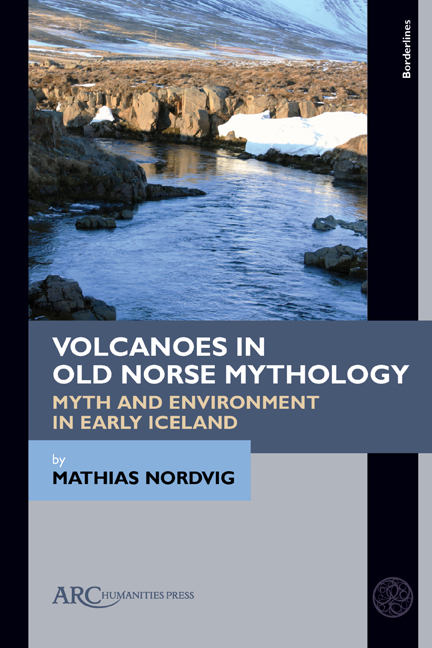Book contents
- Frontmatter
- Contents
- Introduction
- Chapter 1 Old Norse Mythology Between Environment and Literature
- Chapter 2 An Indigenous Theory of Volcanism in Iceland
- Chapter 3 Volcanism in Old Norse Cosmogony
- Chapter 4 Volcanoes in the Social Order of Old Norse Mythology
- Chapter 5 Volcanoes as a Cosmological Principle in Old Norse Mythology
- Bibliography
- Index
Chapter 1 - Old Norse Mythology Between Environment and Literature
Published online by Cambridge University Press: 13 April 2021
- Frontmatter
- Contents
- Introduction
- Chapter 1 Old Norse Mythology Between Environment and Literature
- Chapter 2 An Indigenous Theory of Volcanism in Iceland
- Chapter 3 Volcanism in Old Norse Cosmogony
- Chapter 4 Volcanoes in the Social Order of Old Norse Mythology
- Chapter 5 Volcanoes as a Cosmological Principle in Old Norse Mythology
- Bibliography
- Index
Summary
THE SOURCES THAT I use in this book comprise the core material of Old Norse mythology. These are the Edda, Eddic poetry, and skaldic poetry. The other narratives that I have chosen have been selected because of their relationship to this core material. In the following I will provide an overview of my view of Old Norse mythology in context of its research tradition. I argue that Old Norse mythology stands between two traditions: an indigenous oral tradition and the Latinate literary tradition of the medieval period. As an indigenous oral tradition Old Norse mythology constitutes social memory. The myths are rooted in the time before codification came to Iceland. With the book medium Old Norse mythology was included in the Latinate script-world. Addressing Old Norse mythology as an indigenous oral tradition therefore requires attention to its current position in the Latinate script-world. It also requires a discussion about what it means that the mythology is an indigenous oral tradition. To understand that I draw on indigenous oral traditions that express human-environmental relationships. I compare Old Norse literature with instructive examples from North America and Papua New Guinea. I use these examples to explain the presence of animist thinking in Old Norse literature in a broad sense and more narrowly in Old Norse mythology. I argue that animist thinking lies at the root of a narration of the world that creates cosmologies, which express aspects of environmental conditions and allow a community that exists in a location with certain imposing features to conceptualize them. My argument is that animism sees the world imbued with the same kind of spirit that humans possess, be it animals, bodies of water, trees, or mountains. This anthropomorphizing of the natural world allows communities to negotiate their position in an environment in a way that has direct impact on the mythologies that they produce. The production of such mythologies relies on establishing a vocabulary that is specific to the location. Such vocabularies are easy to discern when the subjects of drought, water, heat, or cold are addressed, but when it comes to volcanism, analogies are more prevalent than directly discernible expressions. This is due to the difference in frequency between the naturally occurring phenomena.
- Type
- Chapter
- Information
- Volcanoes in Old Norse MythologyMyth and Environment in Early Iceland, pp. 5 - 32Publisher: Amsterdam University PressPrint publication year: 2021



